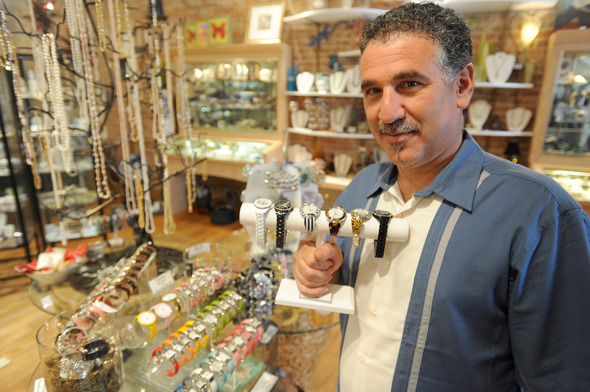As Art Fairs approach, Ann Arbor merchants brace for crowds, big windfalls

Alan Freedman stands inside of Four Directions with watches and other merchandise to be sold July 21-24 at the Ann Arbor Art Fairs. The store, on South Main Street, will participate in merchant sidewalk sales during the annual summer event.
Angela J. Cesere | AnnArbor.com
That pretty much sums up the strategy of local businesses as the Ann Arbor Art Fairs near.
"Many of our merchants have their biggest four days of the year," says Tom Heywood, executive director of the State Street Area Association, which provides tents, promotion, setup and cleanup. "Most are out on the street directly interacting with the people, same as the artists. We've been doing this for years, so our people are totally prepared."
About 50 of the association's 100 members join the 325 artists in the State Street area fair, Heywood says. He estimates that 20 percent of fairs visitors come for the merchant sales.
This year's event, set for July 21-24, is expected to draw more visitors than the last five, according to the Ann Arbor Convention & Visitors Bureau, and the addition of an old- fashioned trolley to ferry around passengers and an Art Fairs iPhone app may help spread the wealth among the four fairs that make up the whole.
Even when times haven't been as flush, the Art Fairs pump tens of millions of dollars into the area. In 2008, a survey of more than 800 visitors - based on the assumption that 500,000 people attended the event - showed expenditures of $49 million in shopping, $25 million in dining, and $5 million in lodging.
Bivouac Ann Arbor on State Street, purveyor of outdoor gear and trendy women's clothing, counts Art Fairs week as its busiest next to Christmas. The store sells items steeply marked down in 80 square feet of tent space outside.
"I sell four times what I normally do at the end of July," says owner Ed Davidson. "The big thing is, it allows me to turn merchandise into cash and get new stuff for fall."
For many retailers, having a strategy that goes beyond price reductions is probably smart, says Maura Thompson of the 150-member Main Street Area Association.
"The retailers who take advantage of the fact that 450,000 people are descending on their sidewalk and think strategically what they should be selling, they are benefiting from art fair," she says.
Four Directions, a Main Street jewelry store, is among those Thompson cites. Owner Alan Freedman has been selling his wares on tables outside the store for 16 years. He says he invests a lot of money in inventory for the fair and tries to price it at $20 or less.
"We're spending a lot of money to find the right products," he says. "There are a couple hundred thousand people, so I want to make as many sales as I can."
Freedman says he knows from experience that Art Fairs visitors want to buy something, even if it isn't art.
"They want to take something home, like a watch or a pendant. We have tables full of jewelry that's under $10," he says.
Next to the Christmas season, Art Fairs week is Four Directions' best.
But for Downtown Home & Garden on Ashley, a block from Main Street, the fair "is an economic wash," says owner Mark Hodesh.
Regulars don't venture downtown, but new customers come in to check out the cookware, wind chimes, canning supplies, seeds, and other cool stuff he carries. Sales are about the same as usual in the end.
"Our basic posture is to keep the bathrooms clean, be friendly, and offer advice," he says.
While Thompson of the Main Street Area Associations says restaurants especially suffer from a lack of regular customers, a few have their strongest sales during fairs week.
"I feel like I feed the whole art fair," says Caroline Kaganov, general manager of Conor O'Neill's Traditional Irish Pub. The restaurant has a booth at the food court on Liberty nearby, and that draws in customers to the restaurant.
Over on South University, Good Time Charley's, which has an outdoor patio, expects big crowds. The fair, says assistant manager Ben Hammond, is stressful on the staff, but "it's a high point for business. Visitors come in for lunch, dinner, beer - everything."
Mary Kerr, president of the Ann Arbor CVB, foresees bigger art fairs crowds this year than during the last five. She says fairs directors have told her that artist applications are up - a key indicator of attendance.
"They feel the economy is turning around and there's a greater appreciation for the handmade," she says. "Last year, we heard from a number of artists that people were buying more, even if attendance was down."
The enthusiasm for the event hasn't yet translated into hotel bookings, but that tends to happen closer to Art Fairs week, says Kerr.
Joe Sefcovic, general manager of the Holiday Inn Near the University of Michigan, Ann Arbor's largest hotel, says he expects to pretty much fill the 225 rooms, especially for Wednesday and Thursday nights. The hotel offers shuttles to and from the fairs.
Sarah Okuyama, who runs the Burnt Toast Inn and Washington House, bed-and-breakfast inns in downtown Ann Arbor, says she has one or two of her 7 rooms available for Art Fairs week. A few rooms were reserved last year for this year's event.
"Art Fair is always good and very important to my business," Okuyama says. "Two months ago, I was pretty well filled up."
Julie Edgar is a freelance writer for AnnArbor.com.


Comments
Dr. I. Emsayin
Sat, Jul 17, 2010 : 10:46 a.m.
Don't forget the Kerrytown area that is full of local merchants in a more relaxed atmosphere.